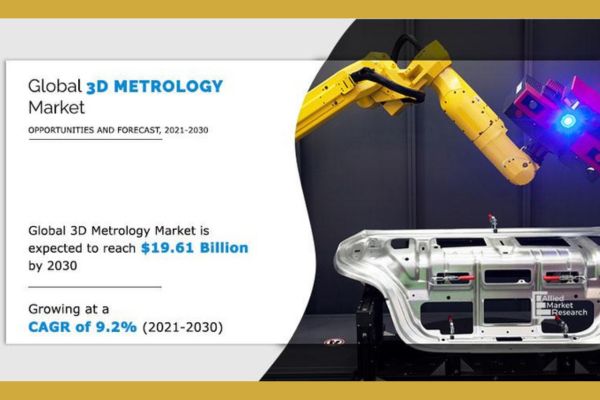3D metrology is an innovative 3D scanning and modeling solution designed for engineering and production. It streamlines the process for engineers and designers to capture high-quality data of their products effortlessly, eliminating the need for manual work. It is associated with various scanning and imaging techniques widely used for many applications, including quality control.
3D metrology supports various manufacturing and engineering activities, including prototyping, tooling, machining, and assembly. It helps reduce costs, increase productivity, and enhance the quality of processes and products. It revolutionizes quality control by offering faster, more accurate, and more comprehensive measurement capabilities than traditional methods. This ultimately enhances product quality and manufacturing efficiency. The 3D metrology industry is witnessing transformation due to a rise in demand for inspection applications and high investments in the R&D of 3D metrology.
The advent of nanometrology for smaller components
The demand for three-dimensional metrology solutions is rising in the field of micro and nano-sized features due to the ongoing miniaturization of electronic components and other goods. Precise measurements at these scales are essential as technology advances. 3D metrology meets this need by offering high-resolution insights that enable industries to maintain stringent production standards for tiny components. This emphasizes the key role of 3D metrology in advancing smaller technologies across various fields.
Nanometrology specializes in measurements at the nanometer scale, where even minor errors lead to substantial impacts. Emerging innovations in nanometrology involve the advancement of specialized instruments like scanning tunneling microscopes (STM) and atomic force microscopes (AFM). These tools resolve issues at the molecular and atomic levels, empowering manufacturers and researchers to characterize nanoscale materials with higher precision.
A new era of medical diagnosis with advanced imaging
In medical diagnostics, precision is important. Traditional 2D imaging, with its inherent limitations, often necessitates doctors to rely on educated assumptions. 3D metrology transforms this process by offering a more comprehensive perspective of the patient’s anatomy. It enables doctors to generate three-dimensional models of a patient’s anatomy, such as the brain or other organs. This offers more detailed information than traditional 2D imaging, enhancing diagnosis accuracy and surgical planning.
For instance, in orthopedics, 3D metrology has revolutionized the fabrication of custom implants and prosthetics. Through extensive 3D orthopedic scans, surgeons design implants that optimize surgical outcomes and accelerate recovery times, ensuring seamless integration with the patient’s anatomy. Similarly, 3D scanning has transformed oncology by providing high resolution images that precisely identify tumor size, shape, and location for precise staging and personalized treatment plans. These scans empower oncologists to develop therapies tailored to target tumors while safeguarding healthy tissue. In surgical contexts, 3D models enable surgeons to visualize and optimize their strategies beforehand, ensuring thorough tumor removal and preservation of critical tissues.
Promising future with technological evolution
In the coming years, the 3D metrology industry is estimated to experience notable advancements such as the incorporation of non-contact measurement technologies like laser scanning and optical digitization. These approaches eliminate the requirement for direct physical contact with the object under scrutiny, which is particularly advantageous for fragile components.
Another significant innovation is the advancement of portable and handheld 3D metrology devices. These innovations are expected to equip technicians and engineers to perform measurements directly on the shop floor or in the field, minimizing downtime and enhancing overall productivity.
ZEISS launched its new 3D metrology software, ZEISS INSPECT
ZEISS introduced its latest 3D metrology software, ZEISS INSPECT, enhancing abilities for Industrial Quality Solutions customers. The new ZEISS INSPECT Optical 3D software facilitates comprehensive inspection and evaluation of 3D measurement data. This release accelerated data acquisition and enhanced evaluation functions. Additionally, the new Autosurfacing app automates the conversion of scan data into precise CAD models, further streamlining workflows. ZEISS INSPECT has established itself as the industry standard for optical metrological inspection and evaluation. It involves CT-based quality inspection in addition to its optical inspection abilities.
Newsight Imaging introduced MT LiDAR in April 2023 for precise 3D mapping
A semiconductor innovator specializing in spectral vision systems and chips and proprietary 3D machine vision sensors, Newsight Imaging Ltd. announced the launch of a new addition to its Multi-Triangulation (MT) LiDAR reference design range. The new reference design enables full 3D mapping with a single scan, featuring 480 depth points and supporting a depth resolution of 20μm to 1mm. It achieves hundreds of frames per second, making it ideal for continuous production and structure inspection control.
In conclusion, the evolution of 3D metrology continues to redefine industries from engineering and manufacturing to medical diagnostics and beyond. Moreover, advancements like non-contact measurement technologies and portable devices, coupled with innovations in software and precision instruments, 3D metrology is anticipated to enhance accuracy, efficiency, and transformative functions for future applications.
Short Description
3D metrology represents an advanced 3D scanning and modeling solution tailored for engineering and production. This technology aids engineers and designers in effortlessly capturing high-precision product data without manual intervention. Moreover, advancements like non-contact measurement technologies and portable devices, coupled with innovations in software and precision instruments, 3D metrology is anticipated to enhance accuracy, efficiency, and transformative functions for future applications.

















